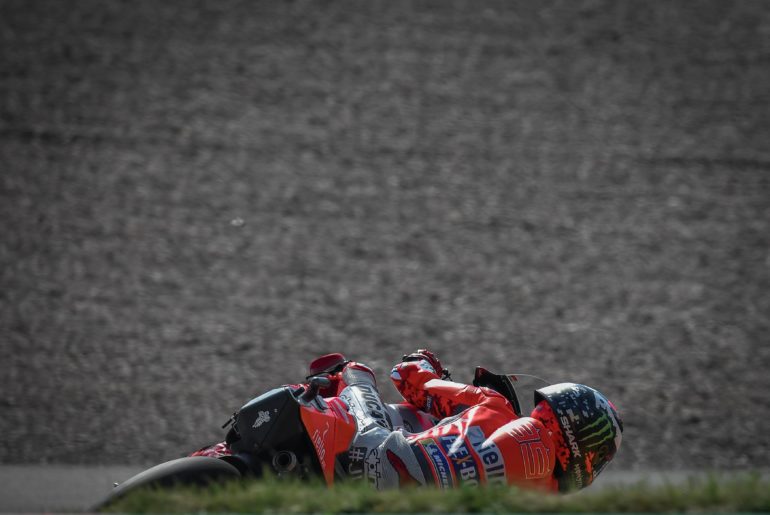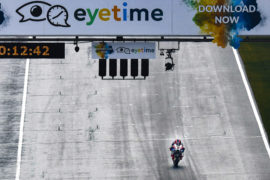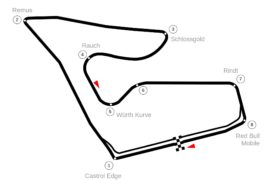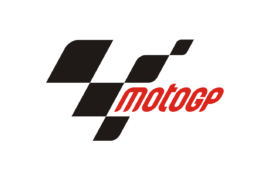As if anyone needed reminding of just how close the MotoGP field is at the moment, you have to go a very long way down the standings to find the first rider more than a second slower than Jorge Lorenzo, the fastest man on the first day of practice at the Sachsenring. Eighteen riders are within a fraction over nine tenths of a second of each other, with Scott Redding the first over a second away.
It’s even closer than that, once you discount Lorenzo’s time. The Factory Ducati rider put in a searing lap at the end of FP2 to go fastest, and was over a quarter of a second quicker than second-place man Danilo Petrucci.
The gap between Petrucci in second and Johann Zarco in eighteenth was 0.645 seconds. Or approximately two blinks of an eye.
That makes it hard to judge riders by position. A tenth of a second would move you up three or four places; three tenths is the difference between eighteenth and eighth.
A small mistake in a single corner could be the difference between being comfortably through to Q2, and going to sleep on Friday night worrying about posting a fast enough time on Saturday morning in FP3.
“I needed to make a perfect lap,” Red Bull KTM’s Pol Espargaro bemoaned his twelfth place, before joking, “or my rivals needed to not make a perfect lap!”
How Does Ducati Do That?
For a track that is all about carrying corner speed, it is surprising to see three Ducatis in the top four, and two more Ducatis in the top ten.
The bike is supposed to have difficulty holding a line in long corners, and the Sachsenring is basically a couple of long corners connected by a couple of changes of direction and a downhill section. Yet Ducatis swamped the top of the timesheets.
Compared to the GP17, Ducati has made major steps forward with the Desmosedici this year, Jorge Lorenzo told us on Friday afternoon. “Looking at the results of today, we are in first position, and with great speed for one or two laps, I would say that the bike has improved a lot, no?” Lorenzo commented.
“But also for example Bautista and Miller, with the old bike, they have been faster, quite close to our lap time, so probably we have not improved as much as we think. Anyway, we have to see the race. Probably our bike can be a little bit better for consistency, because theoretically, it has more turning in the corners. But yes, in such a close championship, small steps are very important.”
He was not as surprised as he might have been at being fastest, the Factory Ducati said. “I knew already that our bike is more complete than last year. I am in great shape at the moment, because I have more experience with the bike, than ever.”
“And the last modifications that we made in the last few months, not only the ergonomics, but also in other areas of the bike, they made our package more competitive. So we arrived here in a good moment.”
“Also, first position is important, but it can also be a little bit from circumstances, because Marc didn’t use a new tire, so maybe we could finish second place today. But we are one of the fastest and we are one of the strongest, also in the Sachsenring. So it’s a nice feeling.”
Bigger Tank
Lorenzo had been helped by a further extension of the tank pad which he first tried at Mugello, and which had helped him to back his first victory on the Ducati. But he downplayed the effect of the new tank pad.
“We are making the last small changes in that area, it doesn’t change too much. Just to try to have even more support in braking. I didn’t feel so much difference, honestly.”
His teammate, fourth behind Danilo Petrucci and Andrea Iannone, concurred with Lorenzo’s assessment. “For sure from last year we are better,” Andrea Dovizioso said.
“There are three Ducatis on top. This is confirmed and this is what I expected yesterday. I’m happy because I think we improved small things everywhere created a good base from the beginning, like in Assen or in Jerez where in the past we struggled. This year we are able to start with a better base. So we are closer to Marc.”
Accelerating while the bike is leaned over has traditionally been a weak spot for Ducati, but Dovizioso believed that some progress had been made in that area.
“Still our turning, especially when the tire drops, is not easy. It’s very difficult to turn fast enough. But like I said before, the base is a bit better so we’re able to make a good lap time.”
The real issue was in how much tire wear there was, Dovizioso explained. “The point is you have to be fast here and you can’t use the best potential of the tire because you can’t finish the race.”
“That is difficult. You can’t exit with the full power. You can’t open where you want. You have to reduce the power, wait until you open the throttle and you have to do the lap time.”
Marc Márquez remained the benchmark for Dovizioso. “We are closer to Marc. Last year he was completely in a different pace. This year we are a bit closer. I don’t know if we have a chance to fight with him because today he was fast, but especially consistent.”
“Here that is very difficult because like the consumption of the rear tire is so high – higher than last year. The speed is one story. To be fast for 30 laps with the rear tire is a different tire is a different story. So the practice shows one thing, but not everything.”
Mr. Consistent
Dovizioso highlighted something which is not so apparent from the headline times, but becomes clear once you dig into the lap times. At first glance, it looks like everyone is very close together, but in reality, Marc Márquez has a much bigger advantage in terms of consistently fast pace.
In race trim, with a medium tire he would go on to put nearly 27 laps on, Márquez did three 1’21.3s, a 1’21.4, and two 1’21.5s. At just over half race distance, he did a couple of 1’21.9s.
By comparison, Jorge Lorenzo and Andrea Dovizioso did 1’21.7s on used tires, Danilo Petrucci popped in a 1’21.8, and Maverick Viñales did a 1’21.9.
The fact that Márquez did not even bother putting in a new soft rear to chase a fast lap time was a sign of just how confident the Repsol Honda rider is. “From the beginning I felt good with the bike,” Márquez said.
“Then we started to work for the race, like every Friday. Just I concentrate on the used tires and try to understand the drop of the tires. We can say it was a good day. This afternoon we did a small improvement and we are working on that, trying to improve a few things on the bike.”
He reiterated that his only concern on Friday had been race pace. “Like I said, we just concentrated on the race pace on Friday, like always,” Márquez told us.
“This morning I did all the session with the same tire – a soft rear. This afternoon I did all the session with medium rear. It looks like for trying to understand how it drops.”
“Then I tried the hard front but it was what we planned. We didn’t put the soft new in the end. For that reason we didn’t improve in the last laps, but it was what we planned because our priorities were another one.”
Same Old Same Old
The Movistar Yamaha team had a better day than usual, but they were soon running into the one limiting factor for the YZR-M1.
Though electronics are not crucial to a good lap time everywhere around the Sachsenring, there are one or two key points where they have to be right, such as the hard acceleration uphill out of the final corner.
Maverick Viñales had ended the day in sixth, slap bang in the middle of the leading group. “I’m actually happy, I felt really good on the bike, I think I’m in really good form,” the Spaniard said.
“But anyway, there are still a lot of things to improve, especially on the electronics, because it’s very important here to have good acceleration, and for the moment, that seems to be very complicated with our bike.”
Teammate Valentino Rossi echoed those sentiments, getting caught between being third fastest in the morning, and seventeenth in the afternoon session. “I think that it’s not true the third place in the morning, but it is also not true the 17th place in the afternoon,” he said.
“I think that we can do better. But unfortunately the problem is always the same. In acceleration, when we open the throttle, we spin too much and we are not able to put enough power on the ground so we lose in acceleration.”
“At the same time also we lose too much the rear tire, so it becomes also difficult to ride the bike. But more or less the problem is that. So tomorrow we try to follow another way, try to make the best and we see our performance.”
The situation surrounding the electronics was a continuing source of frustration, both for Rossi and for Maverick Viñales. “It’s a difficult situation because for me we have this problem from August 2017,” Rossi said.
“And I said a lot of times, but sincerely at this moment also if it’s July 2018 we don’t try anything new. More or less we are like last year. So we have to be optimistic and hope that we can try something because for me personally and I said a lot of times to Yamaha, the problem is very clear.”
A Straight, And a Not-So-Straight Answer
The Movistar Yamaha riders had been hoping to have an update at the Sachsenring, but they have nothing new for the moment. “Right now, no,” Viñales told us. “We don’t have anything new. So still, we have to wait for the summer.”
He was vague on whether Brno would be the race where Yamaha brought updates for them, but it needed to be soon.
“It’s important. Because right now, our bike has a good package, a good base setup, but the electronics limit us a lot. So we need to work hard on that. I think the bike is really good, we just need to set it up well.”
There have long been rumors that Viñales was looking for other changes as well, but the Spaniard downplayed rumors he was looking to find a new crew chief.
In response to a direct question, he deftly danced around the question without offering a clear answer, while still managing to hint at changes still to come.
“Actually, everyone is trying to find the best,” Viñales mused, before hinting at a change. “I think it’s going to be good for the group finally to have something new, trying to improve a little bit more, looking more to the future.”
Viñales then leaped to the defense of his current crew chief, while still managing to leave the door open to the possibility of change.
“I’m really happy with Ramon, Ramon is working always really hard, and technically it will be very difficult to have someone better. But anyway, we are looking forward to different things, and finally it’s like that.”
If Viñales does decide to swap crew chiefs, he won’t make a decision straight away, he told us. “Right now, my focus is on this season, so I’m not thinking about next year. First we need to do this season well, and then I will think. At the moment, nothing, I didn’t think about it.”
Keeping a Clean Sheet
One peculiarity from Friday was the fact that there were so very few crashes, and none at all at the Sachenring’s notorious Turn 11, now renamed the Ralf Waldmann Curve. That was in part because the weather was simply outstanding, bright sunshine and warm temperatures both morning and afternoon.
The track temperature in FP1 was nearly eight degrees warmer than it was during the hottest session last year, the race. And the temperature in FP2 was warmer than every session that Michelin has had at the track since their return, bar Q2 in 2016.
Given the rules introduced this year at the request of the teams, this could have been a disaster for Michelin. The tire allocation for every race had to be fixed before the beginning of the season, allowing very little flexibility.
This has made it much more difficult to get it right, as MotoGP has had some surprising weather conditions so far throughout the year, with temperatures both colder and much warmer than expected.
In its first two years in the class, Michelin were able to wait until the weekend preceding a race before deciding exactly which constructions and compounds to use, meaning that the compounds were far better suited to the temperatures they expected to find at a track according to the weather forecasts.
Now, they have to guess at what the weather will probably be in six or eight months time, and plan their tire compounds accordingly.
When Planning Gets Lucky
So far, Michelin have done remarkably well at the Sachsenring. Tires got very hot, but held up well, though performance tended to drop off after a number of laps. Riders were fairly happy with the tire allocation which Michelin had brought.
“Honestly speaking, it’s a good tire allocation,” Marc Márquez said. “It’s true that the rear is at the limit to finish all the race at a very strong pace, but for everyone it’s the same.”
“The tire allocation is a good one. Maybe the rear is too soft, in a soft way. But sometimes it’s difficult to understand in a good way, because you can put in a harder tire and it’s even worse. But they’re working quite good, the tires.”
Valentino Rossi agreed, and felt some sympathy for Michelin. “For me, the tire allocation is not too bad,” Rossi said. “But I agree that it’s very difficult also for Michelin to make all the tire allocation before the season.”
“Like seven-eight months ago. So maybe it’s more clever to try to reduce the time, when it’s possible, or make the first half and then after some months make the second half. Because also with more experience Michelin can understand better the allocation.”
Unknown Future
Scott Redding can’t even look seven or eight months into the future at the moment. The Englishman finds himself in something of a dilemma over next season, and managed to speak both frankly and very entertainingly about the choices he faces next year, and the options open to him.
Had he had any more thoughts about next year, veteran journo Mat Oxley asked Redding? “No, mate,” Redding replied, exasperated. “What’s there to think about? I don’t have a say in anything.”
That is not strictly accurate, of course, as Redding has a number of options, though none of them include a full-time seat in MotoGP for 2019. Aprilia have offered him a testing role, but the Englishman was in two minds about it.
“They’ve offered me to be a test rider, but it’s not my first choice at the moment,” Redding said. “I’m 25, I’ve got the fire to want to win, and I ain’t going to get that riding round a test track on my own. If that’s like the last option I’ve got, then OK, I need to take it and see if I can bring something after. But I want to race.”
As a test rider, Redding would still be able to participate in a maximum of six races each year as a wildcard, but the example of Michele Pirro had deterred Redding. “People say, ‘if you do it you’ve got a chance to come back’,” Redding said.
“But you’ve got no chance to come back. Look at Pirro, does an amazing job when he races, but he’s never going to come back. Or Kallio. Once you’re gone, you’re gone, I just need to accept that.”
If Redding was offered the chance of racing in WorldSBK, and combining it with a role as a test rider, then he might give it some thought, he told us.
“Maybe if I can race the Superbike and be a test rider, it could be quite interesting, and maybe the Superbike is not the best bike out there, but I’m racing, and that’s what I need to accept.”
That was not something which Aprilia had offered Redding, in part because the Noale manufacturer doesn’t have a factory team in the WorldSBK series.
“It’s not really a factory team for Aprilia, it’s run by other people, so I’ve only thought about maybe doing that possibility last week, but I want to have something competitive to fight for victories, that’s what my main target is.”
“It’s going to be difficult to find the right thing, but I need to see. And if it’s somewhere to take me two years, and then maybe the third year we have something to make another step forward, then I’ve got to take it on the chin, and take it. But I don’t want to be running around as a test rider.”
No to Moto2
Stepping back to Moto2 did not offer a path back into MotoGP, Redding believed. “It’s a great class, but if I go there, there’s a possibility I can win the championship. A possibility,” Redding told us.
“But there’s all these young guys coming up, probably with the same talent, the same ego, the same fire to want to win, and they are with like 10-15kg less weight than me. So to fight for a title, that’s why it was hard for me in the past.”
“There were many races I had closed with Pol, but many times, he just got me to the line because he was lighter. So again, if I won the championship there, would I go back to MotoGP? No, no one would take you because of your past. So I’ve thought about it, but I don’t think it’s really the right way for me to go.”
There were plenty of examples of riders who had gone back to Moto2 after being in MotoGP, and had struggled, Redding said. “Look at all the guys who go back from MotoGP to Moto2. Excluding Elias, because it was a new class for everyone and completely different.”
“You know, they’re good quality riders, but taking a step back, maybe it’s much more difficult than we think it is to step back. No electronics, completely different tires, different brakes, different riding style. There’s so many things that you have to consider, that maybe it’s hard to go back to it.”
Of course, the major change in Moto2 might offer a rider such as Redding an opportunity. The Honda CBR600RR engines are to be replaced by Triumph 765cc triples.
Even better, the Honda Superstock electronics kit – a very simple engine management system, with next to no functionality – is to be switched out for a custom Magneti Marelli ECU, allowing a lot more control of engine braking, traction control, anti-wheelie, and more.
The bigger triple would even have more torque, which could help the tall Englishman, as it would mean his weight would not be as big a factor.
But Redding was entertainingly dismissive of such talk. “Yeah, but the torque on a 600 couldn’t pull the skin off a rice pudding, so I don’t know what the **** you want electronics for…” he joked.
That may be true. But it leaves him in limbo, along with Bradley Smith, Xavier Simeon, Karel Abraham, Tom Lüthi. The influx of newcomers into MotoGP is taking its toll.
Photo: MotoGP
This article was originally published on MotoMatters, and is republished here on Asphalt & Rubber with permission by the author.




